The article “KÁRDAKES” by Rüdiger Schmitt was originally published in the Encyclopedia Iranica on December 15, 2010 and last updated on April 24, 2012. The article “KÁRDAKES” is also available in print (Vol. XV, Fasc. 5, pp. 556-557). Kindly note that the images and accompanying captions inserted into the version printed below do not appear in the original Encyclopedia Iranica publication.
For more on these topics see:
= = = = = = = =
KÁRDAKES, the name of a Persian military unit mentioned several times by Greek and Roman authors, nearly always in relation to the Achaemenid period (cf. Huyse, p. 199, n. 6). Notwithstanding the rather muddled terminology found in the sources, the crucial pieces of evidence are the two references in Arrian, Anabasis 2.8.6 and Cornelius Nepos, Datames 8.2: according to Arrian, 60,000 kárdakes, who were “also hoplites,” as he says, that is, infantry heavily armed like hoplites, fought in Darius III’s army at the battle of Issus (333 BCE) on both sides of 30,000 Greek mercenaries at the very front (whereas in Anabasis 3.11.3-7 he does not mention them in the line-up for the battle of Gaugamela). According to Nepos, Artaxerxes II’s loyal general Autophradates had in his army, marching against the rebellious satrap Datames sometime during the 360s BCE, among others, “100,000 foot-soldiers, whom they [scil. the Persians] call kardakes” (peditum centum milia, quos illi cardacas appellant); even if the number given is to be doubted, Nepos obviously is well-informed here; his source probably is Dinon, as is the case elsewhere.
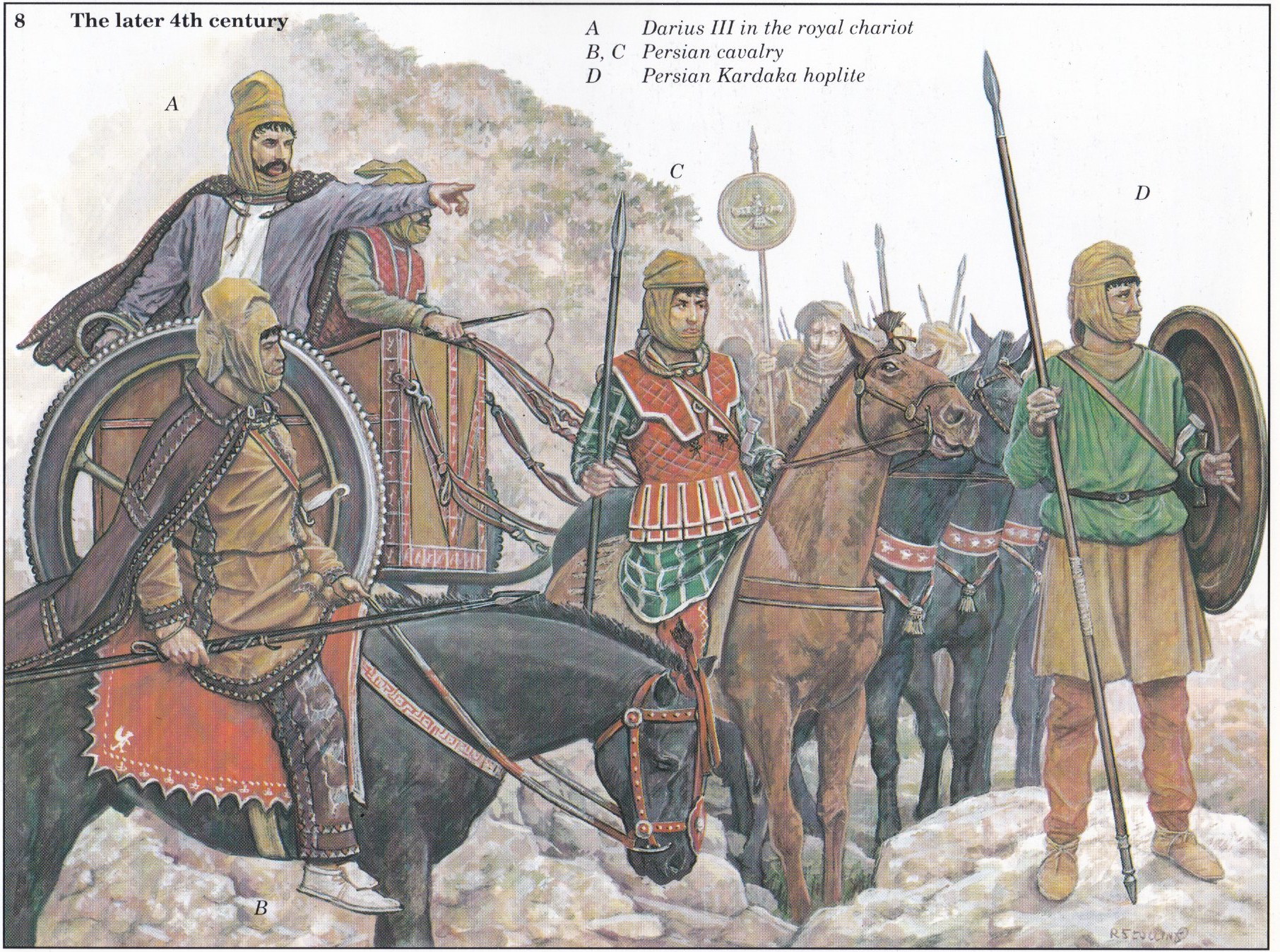
Historical reconstruction by Duncan Head (illustrator is Richard Scollins) of Darius III along with his elite cavalry and a member of the Kardaka (at far left) (Source: Head, H. (1992). The Achaemenid Persian Army. Stockport, England: Montvert Publications).
The mode of expression found in both Arrian and Nepos (as it were, “the so-called kárdakes”) makes it quite certain that here a Persian technical term is involved. Both authors distinguish plainly between three main sections of the army: Greek mercenaries, contingents recruited from the subject peoples, and the actual “barbarian” infantry and cavalry (cf. Briant, 1996, p. 816); thus it seems clear that the kárdakes were Persian infantry similar to Greek hoplites (ibid., p. 1063) and that the common translation “mercenaries” is wrong. It should be added that the passage in Arrian is the only place in the works of the historians of Alexander’s campaign where this term is used; Curtius Rufus (3.9.2-3) in the same context mentions “barbarian infantry” (barbari pedites, led by a Thessalian named Aristomedes) instead of the kárdakes next to the 30,000 Greek mercenaries (cf. Sekunda, 1992, p. 52).
Kárdakes turns up again, as a military term of Seleucid times, in Polybius (5.79.11). According to him Antiochus III in the battle of Raphia in 217 BCE had, among others, 500 Lydian spearmen and a corps of 1,000 kárdakes under the command of the Galatian Lysimachus, posted on the left wing together with 2,000 cavalry (5.82.1).
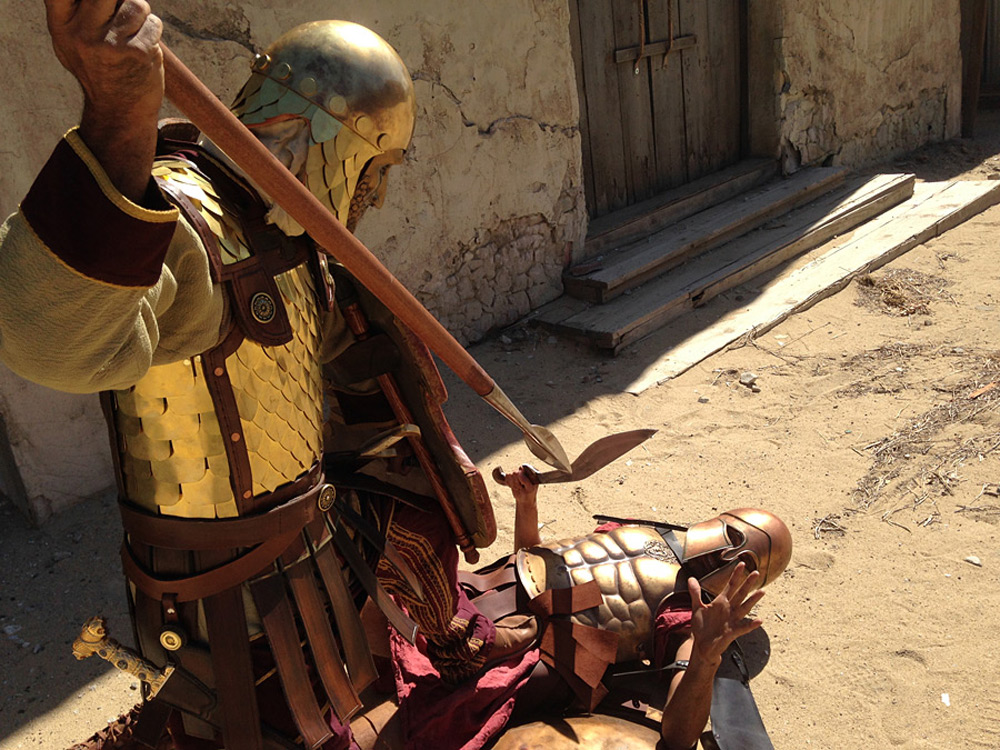
Recreation by Ardashir Radpour of combat between an Achaemenid Elite infantryman versus a Hellenic warrior (Source: Ardashir Radpour). Radpour’s recreation is consistent with what is known of the Immortal Guards for example, however a precise reconstruction of the Kardaka has remained challenging for scholars.
From these sources and others no longer extant, the word was known to Greek lexicographers and Byzantine scholars; they had no real knowledge, however, of the exact meaning of this term and therefore wavered between “soldiers in Asia,” “foreign mercenaries,” “foreign soldiers under Persian command,” or similar definitions. Aelius Dionysius, a 2nd-century CE lexicographer quoted by the Byzantine Eustathius (368.38 ff.; cf. Erbse, 1950, p. 125), has a quotation from a certain Theopompus, whom Erbse (ibid., p. 44) has identified as the comic poet Theopompus dating to ca. 400 BCE, so that the earliest occurrence (and perhaps the meaning “mercenary”) must be accepted for that time. Aelius’s contemporary Pausanias, likewise an Atticist lexicographer, who is quoted by Eustathius (368.37 f.) and Photius (cf. Erbse, p. 188), gives the interpretation “soldiers in Asia” (and as an alternative “guards”); this is also found in Hesychius (K-788), as the second gloss (after “foreign soldiers under Persian command,” hoi strateusámenoi bárbaroi hypò Persôn), with the specification added that these soldiers were conscripted “neither according to éthnos nor according to place of origin.” This confirms that they did not belong to the contingents recruited from the various tribes living in the empire, and that they “certainly are troops not levied hastily but armed uniformly and trained carefully” (Briant, 1999, p. 121).
An indirect reflection of this military term is found also in a Greek inscription from Telmessus in Lycia (first edited by Segre, 1938, pp. 190 ff.), which contains a letter dated 181 BCE with the reply of the Attalid king Eumenes II to an official named Artemidoros about petitions of the people living in the “Village of Kárdakes”; the place may be localized best as near Telmessus (cf. Zgusta, 1984, pp. 228 f.; Tietz, 2003, pp. 351 f.). Because those particular Kárdakes, as the text shows, were not exempt from paying taxes, the thesis is convincing that this village had been founded by retired kárdakes long before the Seleucid period and that it was in reality an Achaemenid military colony (cf. Sekunda, 1991, pp. 105 f.; Keen, 1998, pp. 64 f.; Tietz, 2003, pp. 346-52; and already Launey, 1949, p. 486, n. 4; unlike Segre, pp. 194, 208; Tarn, 1950, pp. 181 f.).
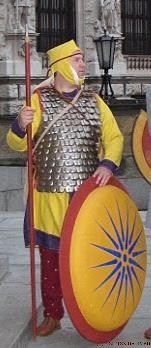
A European enthusiast in reconstruction of an Achaemenid Kardaka (Source: Gentes Danubii – link [https://www.gentes-danubii.at/neu/images/darstellung/Perser/marko.jpg] no longer working).
Matters are complicated, however, by one further occurrence of the word: in the chapter on the education of the young Persians, Strabo (15.3.18), who does not name his source explicitly (perhaps Hecataeus), says that those young Persians who are trained in many things, among them the use of weapons, up to 24 years of age (when their service as infantry or cavalry began) are called kárdakes, because they live by brigandage. He adds the etymological explanation that “kárda means manly and warlike.” This passage, which is somewhat surprising in its place, or even out of place, often has been suspected of being interpolated; but such an assumption is not absolutely necessary and indeed seems to be required only for the three words “living by brigandage.”
The evidence of the historians makes it clear that the term kárdakes in Achaemenid (and Seleucid) times refers to some not exclusively Persian elite infantry, but in any case refers neither to the ordinary Persian conscripts nor to foreign mercenaries, as some scholars had assumed (cf. Tarn, 1950, p. 180; Bosworth, 1980, p. 208), nor to “itinerant soldiers” or the like, as was proposed repeatedly in more recent times, chiefly for etymological reasons (but see below). Problems arise only when one tries to combine Strabo’s information about the hard-trained young men called kárdakes with that of elite infantry. In contrast to Tarn’s (pp. 180-82) absurd assumption that those young men fought at Issus in the frontline or to Widengren’s (1968, pp. 527 f.; 1969, p. 83; cf. Bremmer, pp. 144 ff.) combination of theories on youths’ or men’s societies, Briant (1996, pp. 340, 819; 1999, pp. 120-22) took Strabo’s words “living by brigandage” seriously. He has presented the hypothesis that kárdakes originally meant only the young men educated and physically trained in the Persian manner just before achieving the status of adults. He suggested that at first perhaps only Persian young men were called kárdakes, but in time the other noble youth of the empire were educated in the same way. At the very end of this development the kárdakes became something like a heavily armed “imperial infantry” recruited among the subject peoples, but commanded by Persians. The supposition by Sekunda (1988, p. 42) that the introduction of such a corps of kárdakes belonged to the military reforms introduced by Datames is without evidence (cf. Briant, 1996, p. 1064).
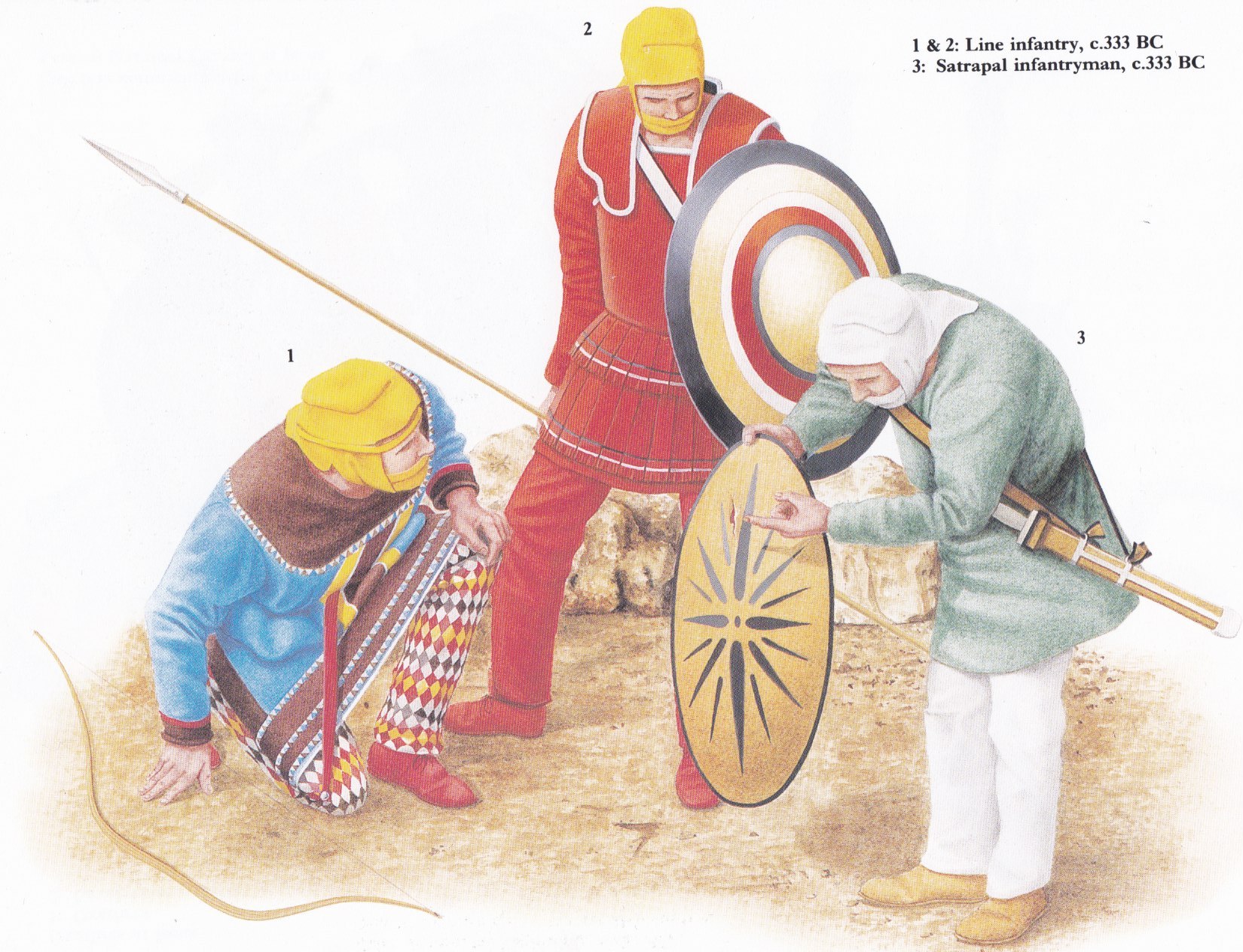
Nicholas Sekunda’s reconstruction of Achaemenid infantry (figures 1-2) and an allied infantryman from the satrapies (Source: Sekunda, N. (1992). The Persian Army 560-330 BC. London, England: Osprey Publications).
For reconstruction of the original OIr. word we must not expect any help from the Babylonian personal names Kar-tak-ku, Ka-ar-ta-ku attested in Nippur under Darius II (which probably reflect some form like OIr. *Kartaka– or *Kṛtaka-) and Syriac Qardāg (cf. Justi, Namenbuch, p. 156; Hinz, 1972, p. 387) or from the Aramaic epithet krtk on a papyrus from Saqqara (TAD, no. B8.3:1), which more probably means “Cretan.” For some time most scholars have identified kárdakes with MPers. kʾldʾkˈ kārdāg, Manich. MPers. qʾrdʾg kārdāg “traveler, wanderer, tramp, migrant” (perhaps also “merchant” but not “mercenary”), as first suggested by Widengren (1968, pp. 527 f.; 1969, pp. 83 f.; cf. Nyberg, pp. 112 f., etc.). On this basis an original OIr. *kāra-tāka– “itinerant soldier” (literally “army-runner”) was postulated (from OPers. kāra– “people, army” and a derivative from the root YAv. tak- “to move, run”) by O. Szemerényi (1971, p. 672 = 1987, p. 1590; Hinz, 1975, p. 148). Most recently, Huyse (p. 199, n. 6) inferred from this etymology that the kárdakes were itinerant soldiers, that is, mercenaries; but evidently such a word could relate just as well, I think, to young men’s bands moving around. This etymology is not without problems, however, caused by the Pahlavi spelling with –d- instead of –t– and by the Greek rendering, which is remarkable for its consonant-stem as well as for its –rd– from *-rat-.
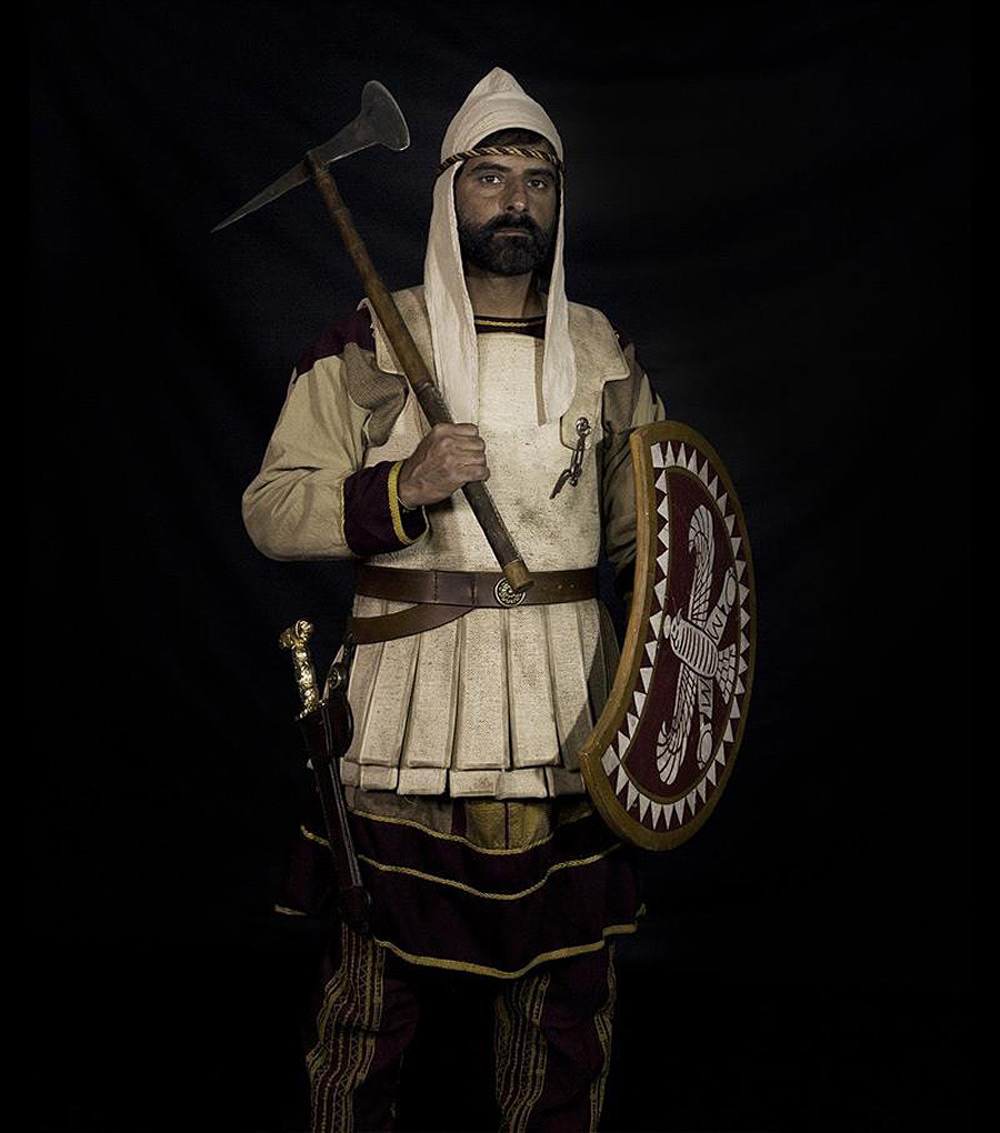
Recreation by Ardashir Radpour of an Achaemenid Elite infantryman (Source: Ardashir Radpour).
All other interpretations proposed so far are not sufficiently supported, however, with regard to morphology and/or semantics and therefore must be dismissed: (1) identification with the name of the Carduchi (considered by Launey, 1949, p. 486, though this is not in accord with the gloss of Hesychius) or even the Kurds (cf. Segre, 1938, p. 194, n. 2; Head, 1992, p. 42); (2) connection with YAv. karəta-, NPers. kard, kārd “knife” (cf. Hemmerdinger, p. 23, and Zgusta, pp. 228 f.); (3) derivation from *kardaka– “manly, warlike” (based on Strabo’s gloss kárda) by Eilers (p. 31), who compared especially NPers. dialectal kal “big, manly, male.” Thus, all in all, the skepticism of Knauth (1975, p. 83) is easy to comprehend, and the question arises whether an alternative form better meeting the documentation can be justified.
Bibliography:
- B. Bosworth, A Historical Commentary on Arrian’s History of Alexander I, Oxford, 1980, p. 208.
- N. Bremmer, “The Suodales of Poplios Valesios,” Zeitschrift für Papyrologie und Epigraphik 47, 1982, pp. 133-47.
Pierre Briant, Histoire de l’Empire Perse. De Cyrus à Alexandre, Paris, 1996, esp. pp. 340, 815 ff., 1063 f.
Idem, “The Achaemenid Empire,” in Kurt Raaflaub and Nathan Rosenstein, eds., War and Society in the Ancient and Medieval Worlds, Washington, D.C., 1999, pp. 105-28.
Wilhelm Eilers, “Einige altiranische Etymologien,” Münchener Studien zur Sprachwissenschaft 45, 1985, pp. 23-38.
Hartmut Erbse, Untersuchungen zu den attizistischen Lexika, Berlin, 1950.
Duncan Head, The Achaemenid Persian Army, Stockport, 1992, esp. pp. 42 f. B. Hemmerdinger, “158 noms communs grecs d’origine iranienne, d’Eschyle au grec moderne,” Byzantinoslavica 30/1, 1969, pp. 18-41.
Walther Hinz, review of Widengren, 1969, in ZDMG 122, 1972, pp. 385-87.
Idem, Altiranisches Sprachgut der Nebenüberlieferungen, Wiesbaden, 1975, p. 148.
Philip Huyse, “Sprachkontakte und Entlehnungen zwischen dem Griechisch/Lateinischen und dem Mitteliranischen,” in M. Schuol et al., eds., Grenzüberschreitungen: Formen des Kontakts zwischen Orient und Okzident im Altertum, Stuttgart, 2002, pp. 197-234, esp. p. 199, n. 6.
Antony G. Keen, Dynastic Lycia, Leiden, 1998. Wolfgang Knauth (with Sejfoddin Nadjmabadi), Das altiranische Fürstenideal von Xenophon bis Ferdousi, Wiesbaden, 1975, pp. 82-84.
- Launey, Recherches sur les armées hellénistiques I, Paris, 1949, p. 486.
Henrik S. Nyberg, A Manual of Pahlavi. 2: Glossary, Wiesbaden, 1974, pp. 112 f.
- Segre, “Iscrizioni di Licia. 1: Tolomeo di Telmesso,” Clara Rhodos 9, 1938, pp. 181-208.
- V. Sekunda, “Some Notes on the Life of Datames,” Iran 26, 1988, pp. 35-53.
Idem, “Achaemenid Settlement in Caria, Lycia and Greater Phrygia,” in Heleen Sancisi-Weerdenburg and Amélie Kuhrt, eds., Asia Minor and Egypt: Old Cultures in a New Empire, Achaemenid History 6, Leiden, 1991, pp. 83-143.
Idem, The Persian Army 560–330 BC, London, 1992, pp. 51-53.
- Szemerényi, review of P. Chantraine, Dictionnaire étymologique de la langue grecque I-II, Paris, 1968-70, in Gnomon 43, 1971, pp. 641-75 (reprinted in Szemerényi, 1987, pp. 1559-93).
Idem, Scripta Minora: Selected Essays in Indo-European, Greek, and Latin. 3, Innsbruck, 1987.
[TAD] Bezalel Porten and Ada Yardeni, Textbook of Aramaic Documents from Ancient Egypt, 4 volumes, Jerusalem, 1986-99.
- W. Tarn, Alexander the Great II, Cambridge, 1950, pp. 180-82.
- Tietz, Der Golf von Fethiye. Politische, ethnische und kulturelle Strukturen einer Grenzregion vom Beginn der nachweisbaren Besiedlung bis in die römische Kaiserziet, Bonn, 2003, pp. 346-52.
Geo Widengren, “Über einige Probleme in der altpersischen Geschichte,” in Josef Meixner and Gerhard Kegel, eds., Festschrift für Leo Brandt zum 60. Geburtstag, Köln and Opladen, 1968, pp. 517-33.
Idem, Der Feudalismus im alten Iran, Köln and Opladen, 1969, pp. 83 f.
Ladislav Zgusta, Kleinasiatische Ortsnamen, Heidelberg, 1984, pp. 228 f.



